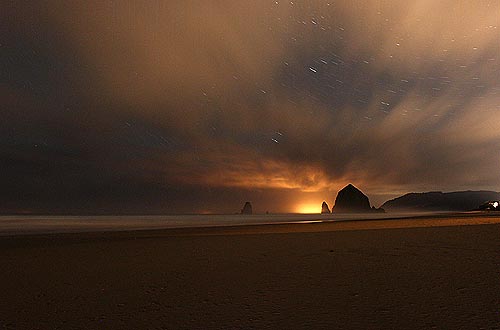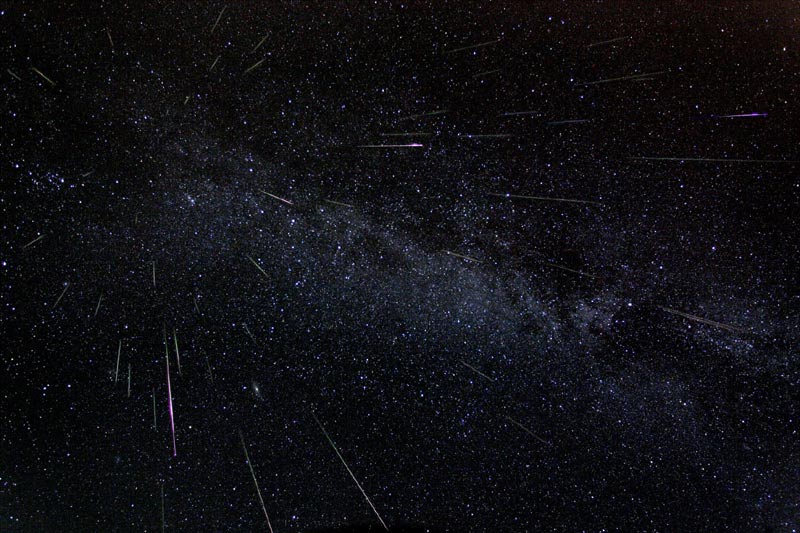Fireball Puts on Rare Show for a Few in Oregon, Washington - But Not Coastline
Published 03/20/21 at 3:50 AM PDT
By Andre' Hagestedt

(Portland, Oregon) – [NOTE: experts want the public and business owners to check their outdoor cameras for 2:11 a.m. if pointed north. You could have footage of this and not know it]
It's not the Oregon coast, where I usually report things I've seen at night – like that oh so glorious glowing sand thing. It's Portland, about 2 a.m. on the morning of March 19, and the Beaverton / Hillsdale Highway near Noodles Restaurant is absolutely devoid of anyone except maybe the odd passing car. (Photo above courtesy NASA: a fireball from a past year. The one seen from Portland did look something like this, however)
Includes exclusive listings; some specials in winter
In Cannon Beach:
Includes rentals not listed anywhere else
In Manzanita, Wheeler, Rockaway Beach:
Some specials for winter
In Pacific City, Oceanside:
Some specials for winter
In Lincoln City:
Some specials for winter
In Depoe Bay, Gleneden Beach:
Some specials for winter
In Newport:
Look for some specials
In Waldport
Some specials for winter
In Yachats, Florence
Some specials for winter
Southern Oregon Coast Hotels / Lodgings
Reedsport to Brookings, places to stay; winter deals
Indeed, I'm not even supposed to insert myself into a story, as a journalist. But at 2:11 a.m. something changes that: I see an incredibly bright meteor-like object stream down the sky in a relatively slow manner. It's two seconds or so worth of dazzling display, not like the quick streak of a faint meteor shower.
It turns out I'm one of the very few in the Pacific Northwest who witnessed this, and only a handful of those who reported it to the American Meteor Society (AMS). I do know it wasn't reported from the Oregon coast or the Washington coast, where it was too overcast. But this fireball was seen from parts of northwest Oregon and southwest Washington, with one other report from Portland and others from around Hillsboro or Vancouver.
By midday on Thursday, the AMS had declared it more than a meteorite given the multiple and similar reports. So I wind up part of the story as I check in with Portland's most well-known astronomer, Jim Todd from OMSI.
As I describe to him in more detail what I'd seen, he agrees it's all typical of a fireball, which is much rarer than a simple meteorite.
"What's the difference?" I ask him. Basically, the size of the object: a fireball – or bolide - comes from something much larger than the usual, tiny meteor.

“A fireball is the result of a single object in the Earth's atmosphere, most likely an asteroid,” Todd said. “They start out a meteoroid and then they enter the Earth's atmosphere and become a meteor. Now what defines a bolide is something bigger than an average meteor shower, which is like a grain of sand, and they go in clusters.”
The object would be one meter or larger.
Todd said they come down as far as 50 miles above us and they last about one to two seconds.
Check that box.
This fireball was a much longer trail – or train, as it's called – and the object itself got intensely bright at the very end, almost a complete white. The train was enormous, spreading out behind the ball and actually expanding, not unlike a jet's vapor trail. But in this case the train had this sparkler effect, firing off little flickers of light, like it had moving serrated edges.
Again, Todd agrees this is “typical of a fireball,” he said. The AMS reports also show – just as I saw – the train breaking up into chunks. There were little holes or gaps in it; some parts remained longer than others.
Another amazing part was that the entire train and the ball were so bright they illuminated the sky around them, in a very narrow range. Enough so that the gaps between and a tiny area around it showed dark blue sky, as if a ways past blue hour. It's not unlike how the moon can turn the sky a bit blue.
Once again Todd said this too is typical.
So why the sparkler effect? His answer was mind-blowing and reminded me of the best of Oregon coast geology.
“The object is very fragile, and it encounters tremendous heat and pressure,” Todd said. “They've been frozen anywhere from thousands to millions of years. All of a sudden they come to an end, and the pressure and energy start breaking them apart, and a lot of material is left behind. Sometimes it's called a plasma train and it's fun to watch.”
That's putting it lightly.
I've seen comet Kohoutek in the early '70s, Hale-Bopp in the ‘90s, some bizarre flashing of the star Sirius, the recent Neowise comet, photographed the Starlink satellites and an iridium flare out around the north Oregon coast, videoed the eclipse, and I'v seen glowing sand happening in Cannon Beach as a meteor shower fired off overhead. This was a rollicking highlight beyond many of those.
It goes to show, be it inland or the Washington or Oregon coasts, make sure you look up at night. MORE PHOTOS BELOW
Oregon Coast Hotels - South Coast Hotels - Where to eat - Maps - Virtual Tours
Cannon Beach Lodging
Nehalem Bay Lodgings
Manzanita Hotels, Lodging
Three Capes Lodging
Pacific City Hotels, Lodging
Lincoln City Lodging
Depoe Bay Lodging
Newport Lodging
Waldport Lodging
Yachats Lodging
Oregon Coast Vacation Rentals
Oregon Coast Lodging Specials
Meteor shower, courtesy NASA

Starlink satellite captured this fall
More About Oregon Coast hotels, lodging.....
More About Oregon Coast Restaurants, Dining.....
LATEST Related Oregon Coast Articles
Through 2 a.m. likely best, but some lights possible through dawn June 1 - 2. Space weather, astronomy
Rare Sperm Whale Stranding on N. Oregon Coast, Was Hit by Boat
Showing up near Gearhart, it will decompose naturally. Marine sciences
Coast Guard Barque 'America's Tall Ship' Coming to Portland Rose Fest, N. Ore...
Portland events: June 5 - 8; Astoria events June 13 - 15. Weather
Bright and Active Arietids Meteors May Hit Pre-Dawn Hours of Oregon, Washingt...
Look to east hour before sunrise and you may catch a show. Sciences, astronomy, weather
Why Now Could Be a Great Week for Spotting Killer Whales on Oregon Coast - Video
A good dozen documentations around Depoe Bay, Newport, Coos Bay, Bandon, Tillamook. Marine sciences
Summer Road Work, Traffic Issues Along Oregon Coast Include Astoria, Garibald...
Some daylight closures include bridges, OR 22, OR 18, OR 26, more. Travel tips. Seaside, Cannon Beach, Lincoln City. Travel tips
Pacific City Oregon Weather, 7-Day Forecasts, Live Conditions, Radar, Webcams...
Updated Constantly: Pacific City, Tierra Del Mar, Oregon Weather, Cams, Buoy Observations, Tides, Warnings - Alerts
Oregon Coast Has World's Oldest Harbor Seal, Celebrating 50 Years Soon
June 3 at Oregon Coast Aquarium in Newport. Newport events
Back to Oregon Coast
Contact Advertise on BeachConnection.net
All Content, unless otherwise attributed, copyright BeachConnection.net Unauthorized use or publication is not permitted
Keywords: Oregon Coast, Washington Coast, travel, Astronomy, beaches, Coos Bay, Westport, Long Beach, Ocean Shores, Seaside, Astoria, Cannon Beach, Manzanita, Science, Portland, Vancouver, Hillsboro




















































